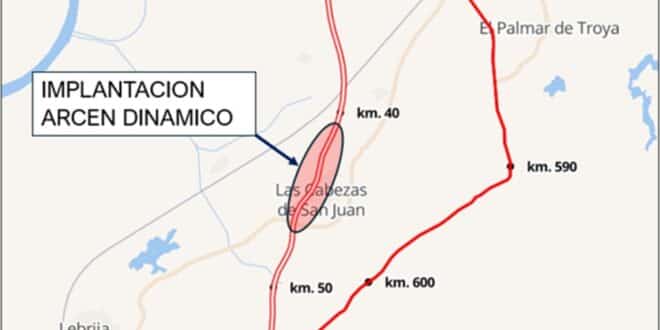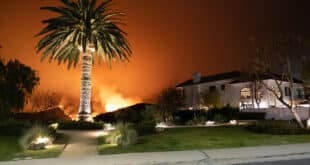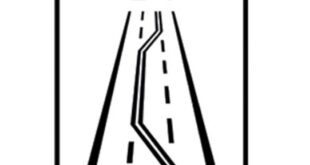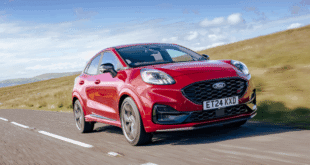Spain’s first dynamic hard shoulder: the AP-4 southbound by Las Cabezas de San Juan (km 41.12–44.5), which DGT will open to cars at peak times when signposted.
Credit : X – Ministerio Transportes y Movilidad Sostenible
@transportesgob
Holiday traffic to Cádiz is about to get a little less hair-pulling. In a first for Spain, the DGT will let cars use the hard shoulder as a live lane on a busy slice of the AP-4 – but only at specific times and only when the signs say so. Imagine it as a temporary extra lane, to keep queues moving.
Where Spain’s hard-shoulder lane starts – and who can use it
The pilot kicks off Friday 9 August on the Cádiz-bound carriageway of the AP-4, between km 41.12 and km 44.5, just before the Las Cabezas de San Juan exit that feeds the A-471 towards Lebrija, Trebujena and Sanlúcar de Barrameda. Variable signs will be used to invite drivers when traffic is heavy. Touring cars To increase the flow, move onto the shoulder. HGVs and busses stay in their normal lanes, preserving emergency access.
This is not a free for all. Outside those peak windows – or if the message boards are dark – the shoulder goes back to being what it’s always been: a refuge lane you must not use. The Ministry of Transport has said that it has remarked and reinforced the shoulder in recent months to ensure it can safely handle moving traffic during activations.
Why DGT bets on dynamic shoulders for the AP-4
You’ll understand why if you’ve ever crawled through this corridor during the summer. The AP-4 is the south’s workhorse, linking Seville with the province of Cádiz and serving both Algeciras Bay logistics and the annual Operation Crossing the Strait. Since 2020, motorway traffic has increased by about 50%. Peak seasons are also a factor.
Instead of pouring concrete, DGT borrows a trick that is used throughout Europe: dynamic hard shoulder running. Authorities point to countries such as Germany, where managed hard-shoulder schemes have delivered capacity gains of up to 25% on bottleneck stretches without denting safety — provided the rules are crystal clear and actively enforced. The logic is straightforward: the shoulder is a dead space during peak hours; by opening it briefly, you can unlock an additional lane at the exact spot where demand is high.
For the AP-4, the pinch point is the 40–44 km section around Las Cabezas, where beach traffic peels off towards the coast. The officials hope that the A-471 drivers will merge more smoothly and intelligently by using a shoulder signposted for them. This should reduce the stop-start waves which ripple out over kilometres.
Signs, speed and safety are all things drivers should be aware of.
This system is idiot-proof. However, it relies on drivers being attentive. The electronic gantries or roadside panels tell you what speed the shoulder opens at. You may use the shoulder if the display displays a green arrow, a lane sign or a symbol of a lane over the shoulder. If it shows a cross in red, then you are not allowed to. Expect temporary speed limits to appear with the activation — they’re there to keep flows smooth and leave room for breakdowns.
DGT: A few ground rules you should know
- It’s not permanent, but it is occasional. If it’s not visible, it’s closed.
- Cars only. The shoulder lane should not be used by lorries or coaches, nor vehicles towing trailers.
- Keep it tidy. Keep it clean.
- Respect all closures. When a red light or an accident sign appears, you should move back onto the main carriageway immediately.
The use of the shoulder while it is closed can still be considered a serious offense and result in a fine or points on your licence. It’s obvious that if you do it correctly, the Las Cabezas line will start to shrink.
Why this matters beyond Cádiz: the AP-4 trial is Spain’s test bed. If data shows shorter queues and less shunting, other hotspots will follow. With tourism up and freight growing, sweating the asphalt we already have is quicker — and far cheaper — than waiting years for new lanes.
Now, anyone driving south should be aware of the gantries located between km 41-45. If you see the hard shoulder light up, then you have a bonus lanes. Use it properly, and your dash to the coast might finally feel like a drive – not a standstill.
 Costa News Spain Breaking News | English News in Spain.
Costa News Spain Breaking News | English News in Spain.





